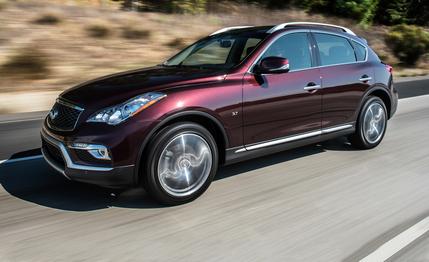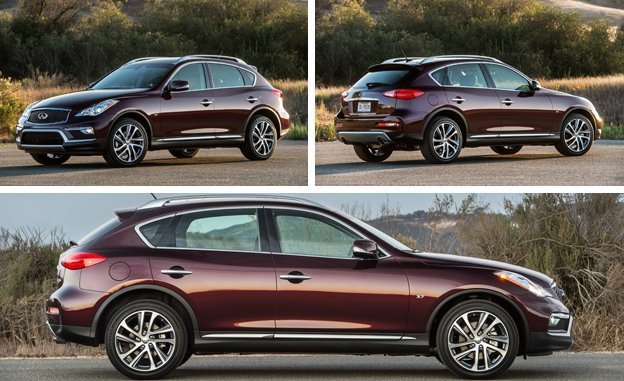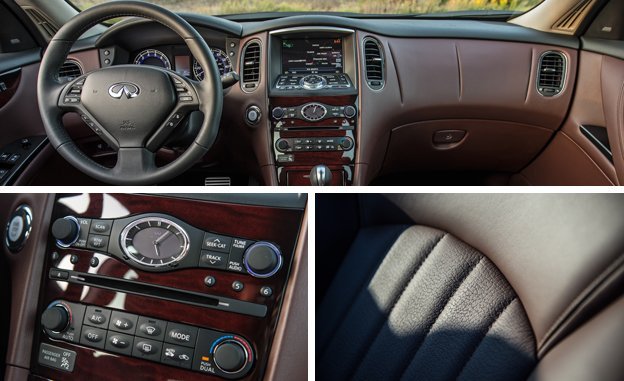
 First Drive Review
First Drive Review
Some questions don’t arise naturally. What would Moses have done with a tablet computer instead of, you know, tablets? Would a horse still be a horse if it had toes instead of hooves? And, the subject here, what would it be like if Infiniti stretched the QX50’s wheelbase by 3.2 inches?
The difference between those first two rhetorical questions and that last one is that Infiniti has in fact gone and stretched the QX50’s wheelbase by 3.2 inches for 2016. So here’s the answer to a question you never thought of and never asked about a relatively obscure crossover.
Remember When
First, let’s clear up some things. The QX50 is the SUV-ish thing formerly known as the EX37 before Infiniti decided to make its inscrutable naming system 44 percent more inscrutable by starting everything with a “Q.” And before it was the EX37 it was the EX35. The EX35 was introduced way back in 2007 when the first iPhone was the only iPhone and it seemed inevitable that Hillary Clinton would be the Democratic nominee for President of the United States. (Some things haven’t changed.)
Whatever it has been called, the QX’s greatest strengths are mechanical. Specifically, those are Nissan’s “FM” front-mid-engine vehicle platform and the VQ-series V-6 engine. The FM bones that underpin the QX also are used as the basis for the Nissan 370Z and Infiniti’s bestselling sedan, the Q50. Every FM-based vehicle benefits from excellent weight distribution thanks to the engine’s placement behind the front axle’s centerline. And they all use control-arm-front and multilink-rear suspension setups. It’s a platform that is designed to deliver balanced handling and a high-performance driving experience, and that carries over to the QX50.


The VQ-series V-6 has been a charismatic (if somewhat coarse) engine from the moment it first appeared in North America in 3.0-liter form and making 190 horsepower under the hood of the 1995 Nissan Maxima. The lyrically named VQ37VHR in the QX now displaces 3.7 liters and is rated at 325 horsepower despite lacking any forced induction or leading-edge technologies such as direct fuel injection. As in other FM-based machines, the V-6 is mounted longitudinally in the QX50 in the traditional rear-wheel-drive configuration.
The seven-speed automatic transmission to which the engine is paired can also be shifted manually using the gear lever. Surprisingly, paddle shifters aren’t offered in the QX50. Make that “perhaps surprisingly,” because after all, paddle shifters were pretty scarce back in model-year 2008—which was, you know, eight years ago.
The Stretch
Market conditions in China practically demanded the QX50’s wheelbase stretch. It’s there, where being driven while riding in the back seat is very much a thing, that the original 110.2-inch wheelbase was a nonstarter. So Infiniti engineered a new roof, new door frames, and new rear doors and also revised the floorpan to get that wheelbase up to 113.4 inches while adding a claimed 4.3 inches more rear legroom and increasing rear kneeroom by 3.9 inches. From the B-pillars forward, the QX50’s appearance is only superficially modified.
Altogether, Infiniti says there is 8.3 additional cubic feet of space inside the stretched QX50. And all of that space goes to passenger accommodation. Leave the back seat up and the cargo capacity remains 18.6 cubic feet, same as in the previous, shorter-wheelbase version.
The QX50 wears its additional length well. In profile it’s maybe even better proportioned than before, with the additional inches visually taking some weight out of the middle. New bumper covers, a revised grille, and new taillights all add to the sense that this old design isn’t really all that old.
Among crossovers, only the Porsche Macan is perhaps sportier. Press the start button and the engine lights off with a subdued snarl. The shifter has a satisfying heft to it, and the leather-wrapped steering wheel is thick and relatively small in diameter. The QX50 feels serious even before you put it into gear.


The chassis is well balanced, rides great, and never seems to lose its composure on road. Both rear- and all-wheel-drive versions were on hand for the press drive, and any driver would be hard-pressed to tell the difference between them in good weather on a grippy surface.
Infiniti states the weight for the lightest QX50 at 3855 pounds, and that’s a lot for any V-6 to hustle. That said, this version of the Nissan VQ is aided greatly by the transmission’s positive upshifts and rev-matched downshifts. It even shifts well manually. It’s such a good, well-sorted transmission that it calls into question why Infiniti’s parent company, Nissan, is otherwise so committed to continuously variable transmissions in many of its other products.
We estimate the new QX50 will get to 60 mph in the mid-to-high five-second range, with a quarter-mile time of just over 14 seconds. The EPA-rated mileage numbers sit at 17 mpg in the city and 24 mpg on the highway for both rear- and all-wheel-drive versions.
Dive into a corner with the QX50 and it bites into the turn almost instantly. The steering is heavy but not particularly communicative, although the 245/45R-19 tires never seem to scream out for mercy. In exposures as brief as this one, the limits of any vehicle’s handling envelope are hardly tested, but our initial impressions are that the QX50 feels shockingly sweet.
That said, the interior is a weird mix of fine details and archaic elements. Throw in the four available option packages and the QX will be equipped with every current tech toy including lane-departure warning, forward-collision warning, blind-spot warning, and more. And yet the navigation screen is a relatively puny seven-incher in an age where vehicles like the Tesla Model S and the Volvo XC90 are using VistaVision screens. The seating, however, is comfortable, the trim is elegant, and, yes, there’s now plenty of legroom in back. So much legroom that any Uber clients will issue instant five-star ratings after their ride.
Prices for the 2016 QX50 start at $35,445 for the rear-drive version and $36,845 for the all-wheel-drive model. Throw everything at one—the $2000 Premium Plus, $2400 Deluxe Touring, and $2750 Technology packages, plus pearlescent paint, the only standalone choice at $500—and the price still falls just shy of $45,000.
After 25 years, Infiniti still may not know quite what it wants to be. But the QX50, which admittedly sells in really tiny numbers and dates back many years, is sort of an unpretentious alternative to cars like the Porsche Macan, offering 80 percent of the driving experience for about 60 percent of the price. That may not be a bad spot to be in at all.